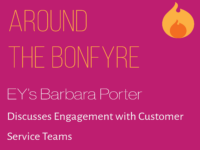For Kristin Hancock, internal communications is instrumental in delivering the employee experience.
As the Manager of Communications for the College of Registered Nurses of Manitoba, Hancock serves that experience to a unique population for someone in her field. The College has a small number of employees, but their internal communications plan reaches an audience of 14,000 registered nurses across the province of Manitoba. As a regulatory agency, the College communicates with this external audience of nurses as an internal one, delivering communications for everything from education and legislation standards to professional conduct disputes. For this edition of Around the Bonfyre, we sat down with Hancock to discuss the challenges of crafting an internal communications plan that connects with such a distinct and expansive population.
This interview has been edited and condensed for clarity.
Related: Internal Communications: Fundamentals for a Strategic Framework
Even for someone within your field, you work with a unique population with particularly diverse needs. What challenges do you encounter that are specific to your role?
The most obvious challenge is connecting with our dispersed population of registered nurses. The 14,000 registered nurses are technically not employees of ours, but they have to be licensed through us. We have their email addresses, but they’re not company email addresses. They don’t work in our physical space. They’re all over the province, which is a huge area to cover. On top of that, being in healthcare, they often are not sitting at a desk in front of a computer all day, if at all. Anyone who has a mobile or remote workforce, or even manufacturing/non-desk employees, can attest that’s the biggest challenge. We have to try harder than many organizations because we do not have as captive of an audience, physically speaking.
What does trying harder look like for someone in your position?
We are becoming a more digital organization. Healthcare traditionally is a very paper-based industry, particularly as a result of documentation requirements. Slowly that is changing, and we’re keeping up. Right now we’re working through a transition where we’re taking our print magazine into a digital format. We’ve previously published and mailed the magazine to the nurses four times a year. Obviously the nurses could not take a magazine with them while they’re on a hospital unit floor. So we’re now taking it online. We’re not simply creating a digital magazine. We’ve decided to revamp our website and use a blog based platform so we can produce content more readily—content that is more accessible, searchable, and relevant for our needs on a regular basis.
Is the shift to digital from print motivated out of a growing obsolescence of the medium?
I’m one of the biggest proponents of the mantra, “Print is not dead.” I think print still has a really powerful place in communications, but where it makes sense. Part of our transition was knowing there’s a generational shift happening in our workforce of registered nurses, and part was budgetary. Even with advertisers, it was still expensive. Print, for the most part, is more expensive than digital.
You’re the second internal communications professional I’ve spoken to who has emphasized that print can be very important—that there’s a “right place” for print. What’s the right place for print today?
The right place for print is where you find the right place for print. I know that circles the question, but I think that answer could be applied to any medium in communications. What’s the right place for email? The right place for email is when you have the right audience for email. There’s only three of us on our communications team. Producing a print magazine every quarter was a labor of love, but it was a labor nonetheless. Producing content on a blog-based platform will in some ways be more work for us, but it will be an opportunity for us to create better, more timely content.
You have a presentation called, “Zero to Hero,” where you advocate for video as a communications channel. I’d love to hear more on your thoughts on video and the role it plays in your internal communications plan.
When we first started looking at video, we looked at it with a narrow view. It was a task. When we started exploring it more, we realized it was key piece in the bigger picture of what we’re doing here. Now when we plan out the next year of communications, it’s a more integral part of our strategy from the start. We incorporate it into communications we’re already doing: our e-news, our website, our social media. We also have a population of registered nurses who are international applicants, or have been internationally educated. One of the next videos we’re working on is specifically for this audience because we’ve found that they’re more likely to watch (and get more out of) a video over reading a text-dense document. It’s been a great way to reach an audience we’ve had more trouble reaching in the past.
There’s a statement on your LinkedIn profile I thought was powerful: “The employee experience defines the customer experience, and internal communications owns that experience.” Could you unpack that statement for us?
I want to first start by saying I shamelessly stole that from Chuck Gose. It may be a paraphrase of his statement, but I have to give him credit for it. The reason I have that on my profile is because for me it was an “A-ha!” moment. If you’re looking to make a case for internal communications in any organization, that’s what ties it together for leadership and C-suite executives. They understand profit. They understand cost reduction. They understand business matters. Internal communications professionals often don’t pitch their roles in a way executives can grasp it. That statement was the link—the link between the customer experience and internal communications—that was so important to share with them. If we’re looking at spending money on a project that impacts the organization internally and doesn’t directly impact it externally, that’s what I use to remind them that what happens internally does have impact externally.
Narrowing down on that internal focus, what’s the most important part of the “employee experience” to you?
Purpose. If employees come to work with a sense of purpose, they’re more engaged and the company performs better.
How do you instill that purpose?
To some degree, I think all organizations have done strategic planning to develop their mission, values, and vision statements. We’ve certainly done that in the more formal sense and then rolled it out to employees by saying, “OK, here are our new statements.” Everyone goes, “OK,” and probably stops listening because they’re weren’t involved in the development of it. We’ve changed that and promoted more engagement by including staff in the strategic planning with the board. Obviously, we can’t have every single staff member at every strategic planning meeting, but there is an opportunity for input. We’re going to continue to involve them that way. We also just launched a new intranet in December of last year. Our peer-to-peer recognition program was just approved this morning.
What excites you about peer-to-peer recognition?
“Connection, and connection tied to purpose. When people are recognized by their peers, there’s more meaning behind it.”
For me, any time I’ve received recognition informally or formally, it means more when it’s coming from a group of my peers. I received a volunteer reward a few months ago. The reason that award meant so much to me was because it was presented from a group of people I really respect. It made it that much sweeter. As human beings,we tend to be hesitant to say that we don’t want recognition. We brush it off and say, “I don’t need a pat on the back.” Yeah, you do! Everyone does!
How do you measure success for your internal communications plan?
We did our very first employee engagement survey in fall of 2016. Did it have its challenges? Were there questions that, after we got the feedback, we realized should’ve been changed? Yes, absolutely. But it was a huge win that we did it for the first time. The biggest win related to that engagement survey is that we also planned a follow up session with all our staff to go through the results. We created a tangible list of action items to improve the questions for the next year, as well as the improve results from the questions that did not have high ratings for the next year. It went even better than I expected it to be. It was a big win for our whole organization. However, I will say in terms of measurement, there is an aspect of engagement that you can’t measure. That’s where emotional intelligence comes into play.
In your opinion, what about it is unmeasurable?
I’m hesitant to put a number on emotion or feelings. For that reason, I believe there will always be an aspect of engagement that is unmeasurable, and that is fine so long as you acknowledge it. We should measure everything we can. I think we all know of companies that on paper look and sound awesome. Maybe they’ve even won awards for being a great place to work. I know people who have worked at some of those places who wouldn’t say that. They’d say it’s a stressful work environment where people don’t really get along. That’s the piece that is missing from employee engagement we can’t quite figure out the recipe for.
Do you feel it requires a different skillset to plan around and strategize for?
Yes, and the fact that there are different aspects of engagement that can’t be measured proves that you need emotionally intelligent leaders in your organization. They’ll be able to sense those things you can’t put a number on.



 6 min
6 min




